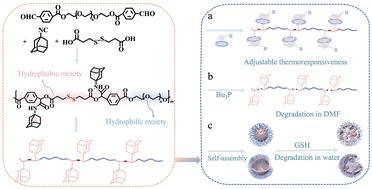当前位置:
X-MOL 学术
›
Polym. Chem.
›
论文详情
Our official English website, www.x-mol.net, welcomes your feedback! (Note: you will need to create a separate account there.)
Degradable polymers with adjustable thermoresponsiveness based on multicomponent polymerization and molecular recognition
Polymer Chemistry ( IF 4.1 ) Pub Date : 2024-06-07 , DOI: 10.1039/d4py00309h Yue Zhang 1, 2 , Shasha Liu 1, 2 , Changlan Xu 1, 2
Polymer Chemistry ( IF 4.1 ) Pub Date : 2024-06-07 , DOI: 10.1039/d4py00309h Yue Zhang 1, 2 , Shasha Liu 1, 2 , Changlan Xu 1, 2
Affiliation

|
Thermoresponsive polymers with lower critical solution temperature have attracted intensive attention due to their wide range of applications as smart materials. Their thermoresponsive behaviors are influenced by the balance between the hydrophobic and hydrophilic moieties present in the polymers. In this research, Passerini multicomponent polymerization of benzaldehyde group-modified poly(ethylene glycol) (PEG) (Mn = 600, 1000, 1500, 2000, or 4000 Da), 3,3′-dithiodipropionic acid, and 1-isocyanoadamantane is conducted to prepare degradable polymers P(PEG) with adjustable thermoresponsiveness. The fractionation of P(PEG) was carried out to obtain fractions with low dispersities. In P(PEG), the balance between the hydrophilic PEG segments and the hydrophobic diethyl disulfide and adamantyl groups greatly affects the dissolution and thermoresponsive behaviors of P(PEG). It was discovered that P(PEG600) and P(PEG1000) were insoluble, while P(PEG1500), P(PEG4000), and most fractions of P(PEG2000) were thermoresponsive with cloud point temperatures (Tcp) ranging from 24.8 to 60.8 °C. The Tcp of P(PEG) increases with increasing Mn of the PEG precursor but decreases with increasing Mn of P(PEG). The Hofmeister effect of the thermoresponsive P(PEG) was investigated using the fraction P(PEG1500)-1 whose Tcp was close to that of poly(N-isopropyl acrylamide). It was found that P(PEG1500)-1 followed the Hofmeister series and exhibited high sensitivity to anions, which is attributed to the high sensitivity of PEG and the alternating structure of hydrophilic and hydrophobic moieties. Based on the molecular recognition between the adamantyl groups of P(PEG) and β-cyclodextrin (β-CD) derivatives, the aqueous solubility and Tcp of P(PEG) could be adjusted. Due to the dynamic interaction of the molecular recognition, P(PEG) could be successively modified with several β-CD derivatives, offering facile control of the Tcp and the zeta potential of the polymer. All the P(PEG) could be degraded in DMF through the cleavage of the disulfide linkages. In water, the assemblies of P(PEG) could also be degraded into about 10 nm fragments when mixed with 10 mM glutathione solution. This degradable PEG-based polymer with adjustable thermoresponsiveness can be applied as a new smart material.
中文翻译:

基于多组分聚合和分子识别的具有可调节热响应性的可降解聚合物
具有较低临界溶液温度的热响应聚合物因其作为智能材料的广泛应用而受到广泛关注。它们的热响应行为受到聚合物中疏水性和亲水性部分之间的平衡的影响。在本研究中,Passerini对苯甲醛基团改性的聚乙二醇(PEG)(M n = 600、1000、1500、2000或4000 Da)、3,3'-二硫代二丙酸进行多组分聚合,和1-异氰基金刚烷制备了具有可调节热响应性的可降解聚合物P(PEG)。对 P(PEG) 进行分级以获得低分散度的级分。在P(PEG)中,亲水性PEG链段与疏水性二乙基二硫醚和金刚烷基之间的平衡极大地影响P(PEG)的溶解和热响应行为。结果发现,P(PEG600)和P(PEG1000)不溶,而P(PEG1500)、P(PEG4000)和P(PEG2000)的大部分馏分具有浊点温度(T cp )的热响应性。 )范围为 24.8 至 60.8 °C。 P(PEG) 的 T cp 随着 PEG 前体 M n 的增加而增加,但随着 P(PEG) M n 的增加而减少。采用T cp 接近聚(N-异丙基丙烯酰胺)的P(PEG1500)-1级分研究了热响应性P(PEG)的霍夫迈斯特效应。结果发现,P(PEG1500)-1遵循霍夫迈斯特级数,对阴离子表现出高敏感性,这归因于PEG的高敏感性以及亲水和疏水部分的交替结构。 基于P(PEG)金刚烷基与β-环糊精(β-CD)衍生物之间的分子识别,可以调节P(PEG)的水溶性和T cp 。由于分子识别的动态相互作用,P(PEG)可以用多种β-CD衍生物连续修饰,从而可以轻松控制聚合物的T cp 和zeta电位。所有的 P(PEG) 都可以在 DMF 中通过二硫键的断裂而降解。在水中,当与 10 mM 谷胱甘肽溶液混合时,P(PEG) 的组装体也可以降解成约 10 nm 的片段。这种具有可调节热响应性的可降解聚乙二醇聚合物可作为一种新型智能材料。
更新日期:2024-06-07
中文翻译:

基于多组分聚合和分子识别的具有可调节热响应性的可降解聚合物
具有较低临界溶液温度的热响应聚合物因其作为智能材料的广泛应用而受到广泛关注。它们的热响应行为受到聚合物中疏水性和亲水性部分之间的平衡的影响。在本研究中,Passerini对苯甲醛基团改性的聚乙二醇(PEG)(M n = 600、1000、1500、2000或4000 Da)、3,3'-二硫代二丙酸进行多组分聚合,和1-异氰基金刚烷制备了具有可调节热响应性的可降解聚合物P(PEG)。对 P(PEG) 进行分级以获得低分散度的级分。在P(PEG)中,亲水性PEG链段与疏水性二乙基二硫醚和金刚烷基之间的平衡极大地影响P(PEG)的溶解和热响应行为。结果发现,P(PEG600)和P(PEG1000)不溶,而P(PEG1500)、P(PEG4000)和P(PEG2000)的大部分馏分具有浊点温度(T cp )的热响应性。 )范围为 24.8 至 60.8 °C。 P(PEG) 的 T cp 随着 PEG 前体 M n 的增加而增加,但随着 P(PEG) M n 的增加而减少。采用T cp 接近聚(N-异丙基丙烯酰胺)的P(PEG1500)-1级分研究了热响应性P(PEG)的霍夫迈斯特效应。结果发现,P(PEG1500)-1遵循霍夫迈斯特级数,对阴离子表现出高敏感性,这归因于PEG的高敏感性以及亲水和疏水部分的交替结构。 基于P(PEG)金刚烷基与β-环糊精(β-CD)衍生物之间的分子识别,可以调节P(PEG)的水溶性和T cp 。由于分子识别的动态相互作用,P(PEG)可以用多种β-CD衍生物连续修饰,从而可以轻松控制聚合物的T cp 和zeta电位。所有的 P(PEG) 都可以在 DMF 中通过二硫键的断裂而降解。在水中,当与 10 mM 谷胱甘肽溶液混合时,P(PEG) 的组装体也可以降解成约 10 nm 的片段。这种具有可调节热响应性的可降解聚乙二醇聚合物可作为一种新型智能材料。












































 京公网安备 11010802027423号
京公网安备 11010802027423号